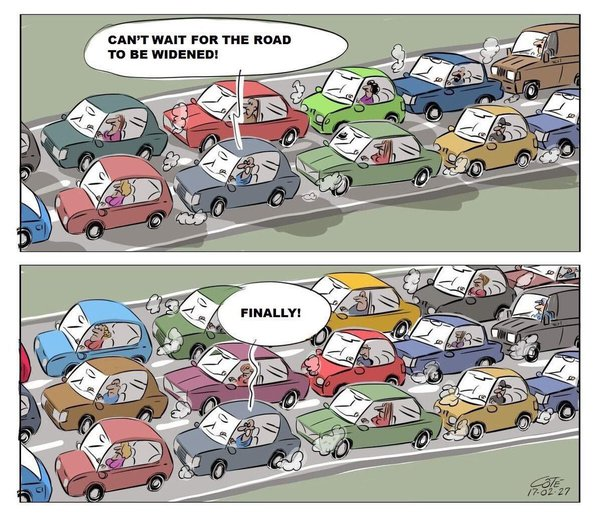My home town of Basel had an amazing idea: why shouldn’t we, in the middle of a climate crisis, build multiple brand new highways that will negatively impact our lives for generations? In the landscape of urban development, the construction of highways is often given as a solution to traffic congestion. However, beneath the surface, the seemingly promising prospect of highways hides a myriad of detrimental consequences. From environmental degradation to life-threatening diseases, the ramifications of building highways extend far beyond their concrete confines. In this blog post, we explore why embarking on the journey of highway construction may lead us down a road we’d rather not travel.
Table of contents
- Killing you from the inside
- Making everyone’s life more miserable
- More highways = More congestion
- Summary
Killing you from the inside
The impact of highway construction and subsequent vehicular emissions on air pollution is profound, with far-reaching health consequences. During construction, heavy machinery releases particles, volatile organic compounds, and nitrogen oxides into the air, contributing to localized pollution hotspots. Once operational, vehicles traveling on highways emit a cocktail of pollutants, including carbon monoxide, sulfur dioxide, and nitrogen oxides, further degrading air quality. To add insult to injury, the wear and tear of car tires generate microplastics and chemical pollutants, further increasing the airborne contaminants.
Prolonged exposure to these pollutants is linked to respiratory ailments such as asthma, bronchitis, and cardiovascular diseases, increasing overall health risks, particularly in communities residing near highways or major roadways. Furthermore, the fine particulate matter can penetrate deep into the lungs and even enter the bloodstream, increasing the risk of lung cancer and other life-threatening conditions. Thus, the cumulative impact of air pollution from construction and car emissions should be enough to argue for the urgent need for sustainable transportation solutions to safeguard public health.
The Oxford University found out that in Great Britain alone, the health damages of pollution amount to £6 billion per year (CHF 6.85 billion). If you are a parent, you might want to consider this - unborn babies and infants breath the same polluted air you do.
“Air pollution accounts for 20% of newborn deaths worldwide, most related to complications of low birth weight and preterm birth.” - Unicef
The question every country should ask themselves is, if it is worth it to damage the live and health of your residents to such lengths to accomidate the needs of car drivers?
Making everyone’s life more miserable
The construction of highways exacts a heavy toll on the environment, causing widespread destruction of domestic wildlife habitats, forests, and local greenery. As bulldozers plow through pristine landscapes to make way for asphalt ribbons, countless species lose their homes. The fragmentation of forests and green spaces by highways isolates wildlife populations, hindering migration and genetic exchange.
So much for the animals, but what about the human cost? The roar of traffic inflicts a relentless assault on the peace and quiet of communities living near highways, subjecting them to the constant onslaught of noise pollution. This disturbance not only disrupts daily life but also poses health risks, including sleep disturbances, elevated stress levels, and impaired cognitive function. Not only will your friends, family, and neighbors sleep worse - the proliferation of asphalt surfaces increases the urban heat island effect and stormwater runoff, further degrading local environments. Thus, the environmental consequences of highway construction extend far beyond the physical footprint, leaving a lasting legacy of ecological degradation and human discomfort.
More highways = More congestion
The concept of induced demand illuminates a fundamental truth about transportation: expanding highway capacity does not decrease traffic congestion but worsens it. Traffic congestion does not originate solely on the highway itself; rather, it begins in the villages and homes of commuters. Thus, increasing space on a highway only serves to accommodate more vehicles, ultimately leading to a surge in overall traffic. This phenomenon results in heightened congestion not only on the highways but also in the surrounding communities that funnel traffic to the newly expanded routes. Induced demand for traffic has been proven empirically many, many times.
Consequently, as we’ve already established, residents living near highways experience intensified noise pollution, decreased air quality, and heightened safety concerns. Not only will building a highway take years, the result will make your community worse of for generations.

Moreover, highway construction diverts resources away from developing sustainable public infrastructure solutions, such as public transit or cycling networks, in these communities. This perpetuates a cycle of car dependency, hindering future efforts to reduce congestion and promote environmentally friendly modes of transportation. Induced demand underscores the need to reevaluate our approach to transportation planning, prioritizing long-term sustainability and community well-being over short-sighted expansion projects.
Summary
In conclusion, the discussion surrounding highway construction and expansion reveals a sobering reality: the purported benefits come at a staggering cost to public health, environmental integrity, and community well-being. From the insidious toll of vehicular emissions on respiratory health to the decimation of wildlife habitats and green spaces, the impacts are far-reaching and mean irreversible damage. The paradox of induced demand highlights that you can not solve traffic congestion by simply building more highways. Instead, it is essential that we shift our focus towards sustainable transportation solutions that consider public health, environmental conservation, and equitable access for all.
There is no solution to car traffic except viable alternatives to driving.



